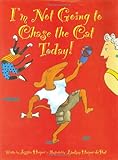Lesson 1: Beginning and End
Lesson Plan
I'm Not Going to Chase the Cat Today | 240L

- Learning Goal
- Identify and describe the beginning of a story.
- Identify and describe the end of a story.
- Duration
- Approximately 50 minutes
- Necessary Materials
- Provided: Independent Practice Worksheet
Not Provided: I’m Not Going to Chase the Cat Today! by Jessica Harper, glue, scissors
-
Activation & Motivation
Provide examples such as daily activities that clearly fall into the beginning of the day and end of the day categories. For example, eating cereal, changing into clothes, and drinking orange juice are activities that are done at the beginning of the day.
-
Teacher Modeling

will explain to students that understanding the order of what happens in a story is important because it helps us understand the story better. I will explain that today we are going to concentrate on thinking about what is happening at the beginning of a story and what is happening at the end of a story. I will model identifying the beginning and the end of a book using a previously read book. For example, in Shelia Rae, The Brave by Kevin Henkes, Shelia Rae was very brave in the beginning of the book. She wasn’t afraid of thunderstorms or dogs or the dark. Model identifying the beginning of the book by doing a picture walk of the first few pages. This is what happened first in the story so it is the beginning of the story. I will look at the end of the book by looking at the last few pages of the story. In the end, Shelia Rae and her sister walked home together and were very brave together. That is what happened at the end of the book. I will read, I’m Not Going to Chase the Cat Today! by Jessica Harper. I will think aloud about what is happening at the beginning of the story, as I read up to page 9.
-
Think Check
Ask: "How did I determine what was happening at the beginning of the story and what was happening at the end of the story?" Students should respond that you looked at the first part of the story to find what is happening at the beginning and you looked at the last part of the story to find what is happening at the end.
-
Guided Practice

will finish reading I’m Not Going to Chase the Cat Today! We will discuss what happened at the end of the book. I will write (with pictures) two events that happened in the book on the board. 1.) The dog woke up from his nap. 2.) The lady, the cat, the dog, and the mouse all shook hands. We will decide which of these events happened at the beginning of the story and which happened at the end. (As the teacher is reading, she or he may choose to briefly discuss what is happening in the middle of the book, but the focus of the discussion should be on the beginning and end.)
-
Independent Practice

will be given two other events from the story. You will decide which event happened at the beginning of the story and which happened at the end. You will cut out the two events and paste them in the correct order. (Independent Practice Worksheet is provided.)
Texts & Materials
Standards Alignment
(To see all of the ReadWorks lessons aligned to your standards, click here.)


Awesome and easy to follow lesson. I am a parent trying to help her children learn and this really simplified the steps for me.
Thank you somuch for awesome sequencing lesson to my kindergartener.
Thank you so much for the excellent sequencing lesson plan.
I like the story that is used for this lesson. Thank you.
I am very grateful for the excellent example of the sequencing lessons; they have helped a great deal.
Thank you for providing a great lesson for sequencing.
This was very useful for the accomplishment of my sequencing lessons.
Thank you.